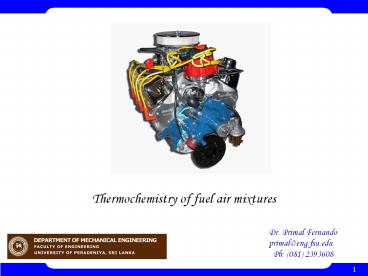Thermal and hydraulic characteristics of brazed plate heat exchangers Part I: Review of single phase and two phase adiabatic and flow boiling characteristics - PowerPoint PPT Presentation
Title:
Thermal and hydraulic characteristics of brazed plate heat exchangers Part I: Review of single phase and two phase adiabatic and flow boiling characteristics
Description:
Thermochemistry of fuel air ... the water vapor is present If products are cooled to an atmospheric pressure ... of brazed plate heat exchangers ... – PowerPoint PPT presentation
Number of Views:326
Avg rating:3.0/5.0
Title: Thermal and hydraulic characteristics of brazed plate heat exchangers Part I: Review of single phase and two phase adiabatic and flow boiling characteristics
1
Thermochemistry of fuel air mixtures
Dr. Primal Fernando primal_at_eng.fsu.edu Ph
(081) 2393608
2
Combustion process
- Thermodynamic aspects of particular type process
involving chemical reactions, is called
combustion - Usually occurs between fuel and an oxygen carrier
(air) - Energy stored in the bonds between constituent
atoms of fuel and air (form of internal energy)
and in the combustion process it will transformed
to new molecules of lower energy level combustion
products plus release heat (exothermic reaction)
3
Combustion process
- Controls the engine power
- Efficiency
- Controls the emissions
- Different for SI and CI engines
4
Flames
- A flame is a combustion reaction propagate
subsonically through space motion of gas
relative to unburn gas is important. - The existence of flame motion implies that the
reaction is confined to a zone which is small in
thickness compared to the engine combustion
chamber. - The reaction zone is usually called the flame
front - Flames can be categorized as premixed and
diffusion flame (mixed together at same place
where the reaction takes place) - Flames also categorized as laminar (mixing and
transport done by molecular process) and
turbulent (enhanced by eddies and lumps) - Flames also categorized by whether the flow is
steady or unsteady
5
Fuel - fossil fuels mainly consists of H and C
By mass
By mass
By volume
6
Chemical equation and conservation of mass
Consider a simple equation
Note all gasses occupy equal volume for kmol
when they are at same pressure and temperature
(exactly true for perfect gases, but for other
gasses substantially true). Volume occupied by
liquid and solids are negligibly small compared
to gasses.
7
Chemical equation and conservation of mass
If insufficient O2 presents
8
Necessary Oxygen is mainly obtained by mixing
fuel with are
Note Molar mass of N2 is 28 kg/kmol (28.16), and
that for air 29 kg/kmol (28.962)
9
Example
- Determine the stoichiometric air/fuel ratio for a
petrol approximating to hexane C6H14. Hence
deduce the chemical equation if the petrol is
burnt in 20 percent excess air, and the wet
volumetric analysis of the products - If all the water vapor is present
- If products are cooled to an atmospheric pressure
and temperature of 1 bar and 15 C. - Determine also the dry volumetric analysis.
- Estimate the chemical equation if only 80 of the
air required for stoichiometric combustion is
provided - The partial pressure of saturated water vapor at
15 C is 0.01704 bar
10
Solution
Products
11
Solution
Wet volumetric analysis of the Products including
N2
Amount-of-substance in the product
12
Solution
Amount-of-substance in the product
The wet volumetric analysis
13
Solution
If products are cooled to an atmospheric pressure
and temperature of 1 bar and 15 C.
Part of water will be condensed, if new amount of
water is y, total substance is 50.79 y
Volume fractionMole fractionpartial
pressure/total pressure
Above volumetric analysis repeats base on the
total volume of 51.67
14
Solution
Determine also the dry volumetric analysis
Analysis is done by assuming no water present,
then the amount of substance becomes 50.79
Above volumetric analysis repeat base on total
volume of 50.79
15
Solution
Chemical reaction with insufficient air (80)
When insufficient O2 is given there will be
unburned C and H2. H2, However, has a greater
affinity for O2. If mixture is not too rich in
fuel, it is reasonable to assume that all the H2
will be burnt. Some of C will be burnt to CO and
other to CO2.
16
General combustion stoichiometry
17
General combustion stoichiometry
Take, yb/a ratio of H2 to C
18
Energy balance
Systems changes from reactants to products (since
mass constant, can apply first law for a close
system)





























